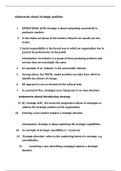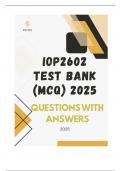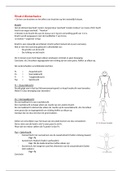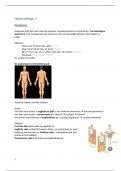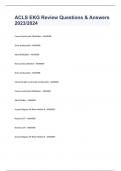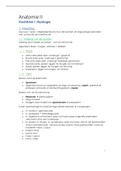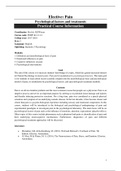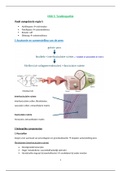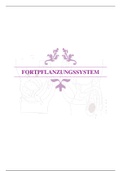Risicotaxatie
Lecture 1:
Forensic risk assessment: the attempt to predict the likelihood of future offending in
order to identify individuals in need of intervention (the process by which the
likelihood of future antisocial behaviour is evaluated)
- Behaviour (violent), potential damage or harm caused by the behaviour (child
sexual abuse), probability that it will occur and under what circumstances
Types of factors
Risk factor: characteristics that increase the likelihood of antisocial behaviour (history
of violence, stress, marital status)
- Static: historical or unchangeable/untreatable (age, gender, ethnicity, first
offense, type of offense, first conviction) provide important information but
can’t be used in the handling of offenders/interventions (StatRec (Static risk of
Recidivism), Static99-R (Static risk assessment tool for sex offenders))
- Dynamic (criminogenic needs): changeable/treatable, interventions aim at the
change of dynamic risk factors RNR model (LS/CMI (level of service/case
management inventory), DRAOR (dynamic risk assessment for offender re-
entry)). Acutely dynamic (modifiable and likely to change (intoxication,
negative mood); ACUTE-2007) or Stably dynamic (modifiable but unlikely to
change (attachment style, impulse control); Stable-2000/2007)
Protective factors: biological, psychological or sociological characteristics that
decrease the likelihood of antisocial behaviour (self-control, intelligence, leisure
activities, medication adherence, healthy peer/family relationships, living
environment)
- Treatment is not only fixing what is broken, it’s also the preservation and
strengthening of what is good
- Protective factors can be conceptualized as prosocial means or strategies to
achieve one or more primary human goods (common life goals)
- Good Lives Model (GLM) of rehabilitation: accomplish a ‘good life’ by fulfilling
primary goods like belonging, peace of mind and happiness (offending =
maladaptive attempt to attain one or more primary human goods)
- Buffer for recidivism, improve prediction accuracy, potentially more engaging
(effective interventions) improvement protective factors (non-recidivism)
SAPROF (Juveniles and young adults, SAPROF-Sexual Offending, SAPROF-
Intellectual Disabilities, SAPROF-Intensive care)
,RNR model (Risk, Need and Reponsivity):
- Risk principle: offenders at higher risk for reoffending will benefit most from
more intensive treatment
- Need principle: only those factors associated with reductions in recidivism
should be targeted during treatment
- Responsivity principle: interventions should be matched to offender
characteristics such as level of motivation, personal circumstances and
learning style
8 central criminogenic needs: antisocial attitudes/orientation, antisocial peers,
antisocial personality, antisocial behaviour patterns, absence of pro-social
leisure/recreation activities, dysfunctional family, employment issues,
substance abuse problems
Non-criminogenic needs: personal distress, major mental disorder, low self-
esteem, low physical activity, poor physical living conditions, low conventional
ambition, insufficient fear of official punishment
Area Under the Curve (AUC): extent to which the risk assessment instruments
accurately differentiate recidivists from non-recidivists
- Derived from Receiver Operating Characteristics (ROC): illustrates
diagnostic ability, plotting true positive rates (sensitivity) against false
positive rates (specificity)
0 (chance performance), 0.5 (uninformative classifier), 1 (perfect
performance)
Cause-effect hypothesis:
- Evidence for an association between risk factors and outcome, namely
reoffending
- There must be a causal relationship in the opposite direction (cause must
precede the occurrence of the effect)
- A cause is different from a consequence
- Do there exist other inter-correlated factors for an observed association?
- When there is a cause between risk factor A and outcome B, the mechanism
must be explained
- Can dynamic risk factors be seen as causes: composite construct (each factor
consists of several sub-factors and/or single factors), lack of specificity (there’s
a lack of explanatory theories, alternative causal explanations), grain problem
(multiple levels ranging from a general domain to a more concrete level, which
level of abstraction?), normative concepts (grey area of social and legal norms
of society) difficult to predict when active, when will lead to crime and
predict/understand why (er kan niet gesproken worden van causaal verband)
Identifying risk & protective factors:
- The empirical method: biopsychosocial characteristics of those who offend are
analysed to see if they systematically differ from those who do not, through
research in which a sample is followed for such a duration as to allow for the
possibility of offending
, - The theoretical method: a particular theory is used to guide decisions as to
which characteristics place an individual at a higher or lower risk of antisocial
behaviour
- The clinical method: identifying individual characteristics which are
changeable and thus can be addressed through clinical intervention
Generations of risk assessment instruments
Contemporary approaches:
- Unstructured clinical judgment (1st generation): the subjective process of
evaluating the likelihood of an adverse outcome without the use of a
structured method (risk assessment tool) but with clinical skills and
experience, not expensive, flexible, convenient, broad accepted, no training
needed, but lack of consistency, lack of transparency, susceptible to biases,
lack of scoring integrity, accuracy equal to chance, poor reliability & validity
- Actuarial assessment (2nd generation): using structured instruments composed
of risk and/or protective, static factors that are found to be associated with the
adverse event of interest using a statistical methodology objective, removal
of human judgment biases, replicable, but limited integration of intervention,
no protective factors, clinical override, unchangeable, a-theoretical
- Structured professional judgment (3rd generation): instruments that are
composed of risk and/or protective, static and/or dynamic factors and
(non-)criminogenic needs that research or theory suggests are associated with
the adverse event of interest Scores are used as an aide-memoire, guiding
administrators in making a categorical risk judgment when combined with
case-specific information gained through clinical experience with the client
being evaluated. Identification of treatment goals, transparent, but more time
consuming, limited integration of intervention
- Structured professional judgement (4th generation): include case planning and
intervention transparent, sensitive to change over time, theoretically sound,
allow for clinical judgement, incorporates interventions, allow for clinical
judgement, but more time consuming, repeated measures to examine
changes, training and expertise
To decide which tool: find a best fit with the population and outcome of interest
Lecture 2:
Juvenile offending:
- Children and adolescents who have committed legal offence (boys > girls)
- Frequently (especially in boys), indicators may be present from a very young
age
4 types of youth delinquents:
- Youth at risk
- First offenders
- Habitual offenders: offending happens more often
- Multiple offenders: high frequency of offending
Lecture 1:
Forensic risk assessment: the attempt to predict the likelihood of future offending in
order to identify individuals in need of intervention (the process by which the
likelihood of future antisocial behaviour is evaluated)
- Behaviour (violent), potential damage or harm caused by the behaviour (child
sexual abuse), probability that it will occur and under what circumstances
Types of factors
Risk factor: characteristics that increase the likelihood of antisocial behaviour (history
of violence, stress, marital status)
- Static: historical or unchangeable/untreatable (age, gender, ethnicity, first
offense, type of offense, first conviction) provide important information but
can’t be used in the handling of offenders/interventions (StatRec (Static risk of
Recidivism), Static99-R (Static risk assessment tool for sex offenders))
- Dynamic (criminogenic needs): changeable/treatable, interventions aim at the
change of dynamic risk factors RNR model (LS/CMI (level of service/case
management inventory), DRAOR (dynamic risk assessment for offender re-
entry)). Acutely dynamic (modifiable and likely to change (intoxication,
negative mood); ACUTE-2007) or Stably dynamic (modifiable but unlikely to
change (attachment style, impulse control); Stable-2000/2007)
Protective factors: biological, psychological or sociological characteristics that
decrease the likelihood of antisocial behaviour (self-control, intelligence, leisure
activities, medication adherence, healthy peer/family relationships, living
environment)
- Treatment is not only fixing what is broken, it’s also the preservation and
strengthening of what is good
- Protective factors can be conceptualized as prosocial means or strategies to
achieve one or more primary human goods (common life goals)
- Good Lives Model (GLM) of rehabilitation: accomplish a ‘good life’ by fulfilling
primary goods like belonging, peace of mind and happiness (offending =
maladaptive attempt to attain one or more primary human goods)
- Buffer for recidivism, improve prediction accuracy, potentially more engaging
(effective interventions) improvement protective factors (non-recidivism)
SAPROF (Juveniles and young adults, SAPROF-Sexual Offending, SAPROF-
Intellectual Disabilities, SAPROF-Intensive care)
,RNR model (Risk, Need and Reponsivity):
- Risk principle: offenders at higher risk for reoffending will benefit most from
more intensive treatment
- Need principle: only those factors associated with reductions in recidivism
should be targeted during treatment
- Responsivity principle: interventions should be matched to offender
characteristics such as level of motivation, personal circumstances and
learning style
8 central criminogenic needs: antisocial attitudes/orientation, antisocial peers,
antisocial personality, antisocial behaviour patterns, absence of pro-social
leisure/recreation activities, dysfunctional family, employment issues,
substance abuse problems
Non-criminogenic needs: personal distress, major mental disorder, low self-
esteem, low physical activity, poor physical living conditions, low conventional
ambition, insufficient fear of official punishment
Area Under the Curve (AUC): extent to which the risk assessment instruments
accurately differentiate recidivists from non-recidivists
- Derived from Receiver Operating Characteristics (ROC): illustrates
diagnostic ability, plotting true positive rates (sensitivity) against false
positive rates (specificity)
0 (chance performance), 0.5 (uninformative classifier), 1 (perfect
performance)
Cause-effect hypothesis:
- Evidence for an association between risk factors and outcome, namely
reoffending
- There must be a causal relationship in the opposite direction (cause must
precede the occurrence of the effect)
- A cause is different from a consequence
- Do there exist other inter-correlated factors for an observed association?
- When there is a cause between risk factor A and outcome B, the mechanism
must be explained
- Can dynamic risk factors be seen as causes: composite construct (each factor
consists of several sub-factors and/or single factors), lack of specificity (there’s
a lack of explanatory theories, alternative causal explanations), grain problem
(multiple levels ranging from a general domain to a more concrete level, which
level of abstraction?), normative concepts (grey area of social and legal norms
of society) difficult to predict when active, when will lead to crime and
predict/understand why (er kan niet gesproken worden van causaal verband)
Identifying risk & protective factors:
- The empirical method: biopsychosocial characteristics of those who offend are
analysed to see if they systematically differ from those who do not, through
research in which a sample is followed for such a duration as to allow for the
possibility of offending
, - The theoretical method: a particular theory is used to guide decisions as to
which characteristics place an individual at a higher or lower risk of antisocial
behaviour
- The clinical method: identifying individual characteristics which are
changeable and thus can be addressed through clinical intervention
Generations of risk assessment instruments
Contemporary approaches:
- Unstructured clinical judgment (1st generation): the subjective process of
evaluating the likelihood of an adverse outcome without the use of a
structured method (risk assessment tool) but with clinical skills and
experience, not expensive, flexible, convenient, broad accepted, no training
needed, but lack of consistency, lack of transparency, susceptible to biases,
lack of scoring integrity, accuracy equal to chance, poor reliability & validity
- Actuarial assessment (2nd generation): using structured instruments composed
of risk and/or protective, static factors that are found to be associated with the
adverse event of interest using a statistical methodology objective, removal
of human judgment biases, replicable, but limited integration of intervention,
no protective factors, clinical override, unchangeable, a-theoretical
- Structured professional judgment (3rd generation): instruments that are
composed of risk and/or protective, static and/or dynamic factors and
(non-)criminogenic needs that research or theory suggests are associated with
the adverse event of interest Scores are used as an aide-memoire, guiding
administrators in making a categorical risk judgment when combined with
case-specific information gained through clinical experience with the client
being evaluated. Identification of treatment goals, transparent, but more time
consuming, limited integration of intervention
- Structured professional judgement (4th generation): include case planning and
intervention transparent, sensitive to change over time, theoretically sound,
allow for clinical judgement, incorporates interventions, allow for clinical
judgement, but more time consuming, repeated measures to examine
changes, training and expertise
To decide which tool: find a best fit with the population and outcome of interest
Lecture 2:
Juvenile offending:
- Children and adolescents who have committed legal offence (boys > girls)
- Frequently (especially in boys), indicators may be present from a very young
age
4 types of youth delinquents:
- Youth at risk
- First offenders
- Habitual offenders: offending happens more often
- Multiple offenders: high frequency of offending



